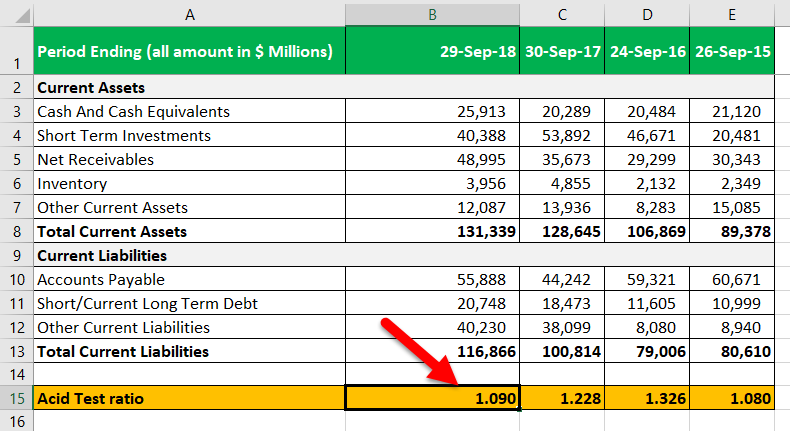Current Ratio Less Than 1
When the current ratio is greater than 1 it means the current liabilities of the company are greater than its current assets whereas. Current Ratio 1.

Acid Test Ratio Meaning Formula Calculation Interpretation
However you should remember that a higher current ratio doesnt always mean that your business is in a healthier financial position.

. In airline business equity to assets ratio is also very low as airlines leverage assets upto 80 to 90 of their total assets because of very high cost of capital. However an investor should also take note of a companys operating cash flow in order to get. Some types of businesses can operate with a current ratio of less than one however.
It might be very common in certain. A current ratio of less than 1 indicates that the company may have problems meeting its short-term obligations. Given the structure of the ratio with assets on top and liabilities on the bottom ratios above 10 are sought after.
They carry high credit risk. The current ratio has numerous advantages that make it superior compared to other liquidity ratios. A ratio of less than 1 eg 075 would imply that a company is not able to satisfy its current liabilities.
A ratio higher than 3 could show an inefficient use of working. This happens if a companys current assets are less than its current liabilities. Current ratio ought to be less than 1.
The higher ratio the higher is the safety margin that the business possesses to meet its current liabilities. Hence most of the airlines would have equity to assets ratio in the range. Conversely a current ratio lower than 1 means the business debts exceed its assets which can be a red flag for financial danger and signifies that you need to improve liquidity.
A good liquidity ratio is anything greater than 1. Enough assets that will convert to cash in time to pay all of the debts payable within the next twelve months. Hence with low current assets and higher current liabilities.
For example a current ratio of 9 or 10 may indicate that your company has. In general a good current ratio is anything over 1 with 15 to 2 being the ideal. More debts due within the next year than assets that should convert ta cash within that same time period.
It indicates that the company is in good financial health and is less likely to face financial hardships. Current Ratio 1 is a potential red flag for investors. A high current ratio can be signs of problems in managing working capital.
Correct option is C Current ratio is the measure of liquidity of a company at the certain date. The liquidity ratio is commonly used by creditors and lenders when deciding. Acceptable current ratios vary from industry to industry.
The current ratio helps in analyzing the capability of an organization in discharging its current financial obligations whereas the quick ratio helps in analyzing the capability of an organization in tackling its immediate cash requirements. When current ratio is low and Current liabilities exceeds current assets the company may have problems in meeting its short term obligations. A ratio of 1 means that a company can exactly pay off all its current liabilities with its current assets.
That being said how good a current ratio is depends on the type of company youre talking about. If the management realizes they have less than 1 of the current ratios they must make a swift decision to salvage the situation. For most industrial companies 15 may be an acceptable current ratio.
A current ratio less than 10 means that current liabilities exceed current assets. A firm having a current ratio less than 10 has. A ratio greater than 1 represents the favorable financial position of having more assets than debts.
Similar to the current ratio a company that has a quick ratio of more than one is usually considered less of a financial risk than a company that has a. By contrast a current ratio of less than 1 may indicate that your business has liquidity problems and may not be financially stable. If this is the case the company has more than enough cash to meet its liabilities while using its capital effectively.
Such companies may have to raise additional funds or sell long-term assets to pay their loans. Low values for the current ratio values less than 1 indicate that a firm may have difficulty meeting current obligations. If inventory turns into cash much more rapidly than the accounts payable become due then the firms current ratio can comfortably remain less than one.
The primary advantage of the current ratio is that the ratio helps measure the financial health of a company.

How To Reduce Current Ratio And Why Economics Lessons Accounting Basics Financial Analysis
:max_bytes(150000):strip_icc()/debtequityratio.asp_FINAL-0ac0c0d22215418a992fa7facd2354e6.png)
Debt To Equity D E Ratio Formula And How To Interpret It


Comments
Post a Comment